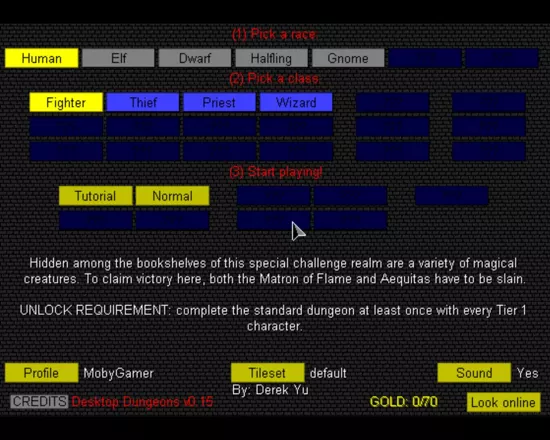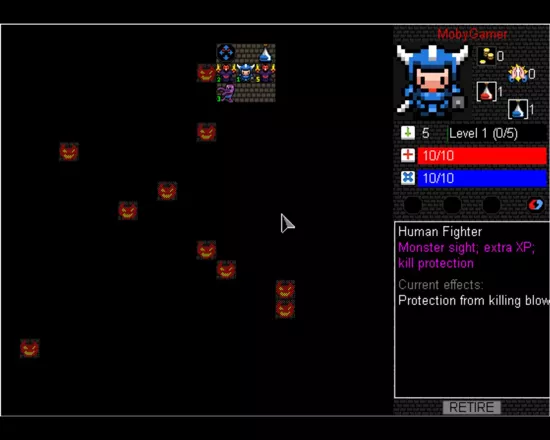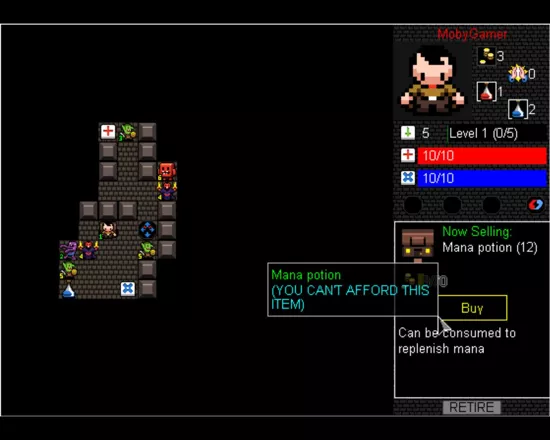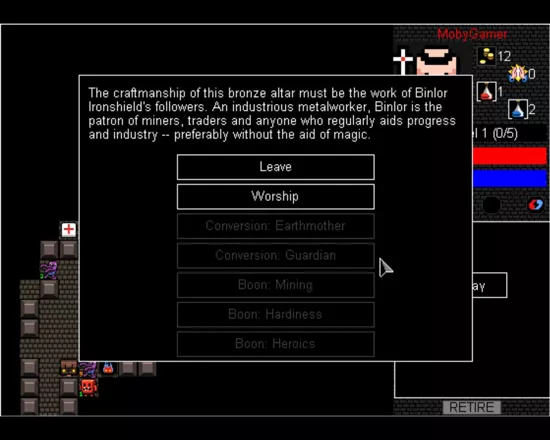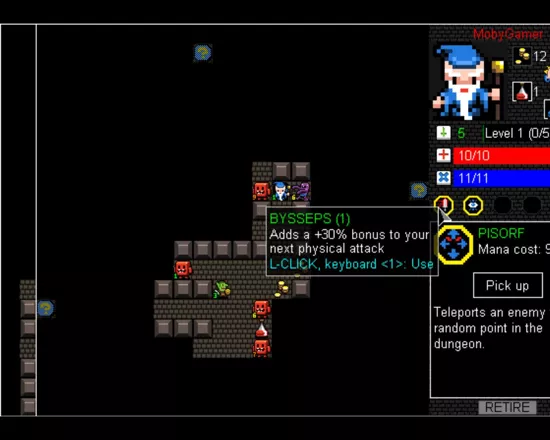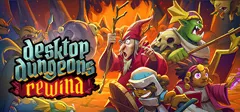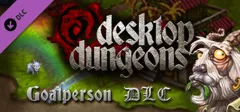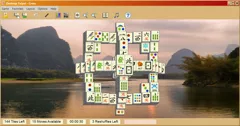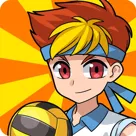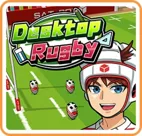Desktop Dungeons
-
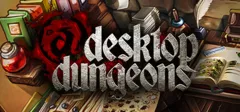 Desktop Dungeons
(2013 on
Windows,
Macintosh, 2014 on
Linux...)
Desktop Dungeons
(2013 on
Windows,
Macintosh, 2014 on
Linux...)
Description
Desktop Dungeons is a medieval fantasy rogue variant game with full 2D graphics, music, and sound. The purpose of the game is to defeat the boss of a selected scenario or die trying.
Race and Class
The player must first select a race and a class for the character. Basic races consist of human, elf, dwarf, halfling, and gnome. Each race has an ability to convert glyphs into a specific attribute (e.g. humans convert glyphs into attack bonus). Glyphs are magical runes/spells that are randomly placed in the dungeon. Basic classes consist of fighter, thief, priest, and wizard. Each class has specified advantages and disadvantages. All classes are capable of melee combat and the use of glyphs (magic). Additional races and classes may be later unlocked.
Combat and Leveling
Combat consists of the player bumping into an enemy, each turn identifying the amount of health subtracted from both parties, which may be continued until one of the parties die or if the player retreats. Unlike other similar games, enemy units here do not move nor do they attack unless attacked first. The level experience of an enemy is always seen to indicate how strong the opponent is.
Leveling up occurs when the player has killed a sufficient quantity of enemies (e.g. 0/15). Acquiring a level allows the player to engage with enemies of the same level, otherwise difficult to defeat.
Deities
The game introduces several deities available for worship when the player manages to reach one of their shrines. Deities offer bonuses, some with disadvantages, most with certain consequences. In order to gain bonuses from a deity, the player must gain favor by increasing piety. Piety is achieved when the player commits certain actions, which may be revealed later when the action is done. Committing an action that displeases a deity, will subtract the piety. Having piety lower than zero may invoke celestial wrath. Worship may be changed from one deity to another at a cost of piety. Deity worship is optional and not required to finish a scenario.
Exploration
Environments are randomly generated and shrouded in a fog of war. Items and monsters are randomly placed. Unexplored regions will become revealed when player approaches it. Revealing unexplored regions also regenerate health and mana per revealed tile.
When a scenario is completed by defeating all the bosses, the game ends. Completing a scenario may unlock additional scenarios, classes, new monsters, or other bonuses.
Groups +
Screenshots
Credits (Windows version)
16 People (9 developers, 7 thanks)
| By | |
| Epic Thanks - Tileset |
|
| Epic Thanks - Additional Characters | |
| Epic Thanks - Sound |
|
| Epic Thanks - Fan Art (Loading Screen) |
|
| Epic Thanks - Fan Art Coloring (Loading Screen) |
|
| Epic Thanks |
|
Reviews
Critics
Average score: 81% (based on 4 ratings)
Players
Average score: 3.6 out of 5 (based on 8 ratings with 1 reviews)
[v1.0] Addictive little Rogue variant game and it's free!
The Good
Review Version: v1.0
Review Date: December 9, 2012.
Review Length: 1 (one) page.
Game Version: v0.105
Tech Specs Used: Intel Core 2 6300 1.86 Ghz CPU, 3 GB Memory, 512 MB NVIDIA GeForce 8500 GT Video Card.
Finished: Almost half done. Tough to beat.
Last time played: December, 2012.
Preferred Character Class: Assassin.
Classes unlocked: 13 out of 15.
Races unlocked: 6 out of 6.
Scenarios unlocked: 6 out 9.
Out of all the Rogue variants out there, this is probably one of less than a handful of those games worth mentioning. Why? First of all, it isn't a total clone of the original Rogue game. Most of the variants just add bigger rooms, items, or basically just adding stuff to the original version. Desktop Dungeons can hardly be called a clone in this regard, because it's a total overhaul, introducing various new and independent features not unique to the original Rogue game. This included classes, races, different scenario types, and a style of rules unique to this game.
The most obvious difference is this game, health and mana regeneration does not regenerate by moving. It's regenerated by exploring unexplored tiles, which is limited. To that extent, the game plays out more as a strategy game as the player has to calculate each turn efficiently enough to regenerate health after each combat encounter while not exploring too much as to limit health and regeneration opportunities.
Graphically, the game is by far one of the most advanced in its immediate genre. It's not based on ASCII graphics as one would expect from Rogue variants. Sound and music is simple but good enough to fit this game. Overall, the combination of all the elements in this game is quite excellent.
The Bad
It's hard.
Unlocking the several features in the game such as classes and scenarios would be a challenge even for hardcore gamers. As in many Rogue variants, luck is an integral variable for the player to successfully beat any given scenario. Luck, hence is mildly annoying if you started off at a bad location, surrounded by high level monsters, and not enough items.
The Bottom Line
This is probably the most modern version of an RPG Tetris game. You know, that kind of game that's small, quick to load, and just play for a several minutes when you're bored. As far as this game goes in its field, I'd give it a solid 8.0-8.5 out of 10. It's small, it's free, and it's fun. Might as well give it a go.
Windows · by Indra was here (20754) · 2012
Analytics
Upgrade to MobyPro to view research rankings!
Related Sites +
-
Desktop Dungeons
play the game in a HTML5-supported browser, free of charge -
Desktop Dungeons Wiki
Desktop Dungeons Wiki! located at QCF Designs website. The front page has a side-by-side comparison of the last freeware version to the new commercial version on Steam.
Identifiers +
Contribute
Are you familiar with this game? Help document and preserve this entry in video game history! If your contribution is approved, you will earn points and be credited as a contributor.
Contributors to this Entry
Game added by Indra was here.
Browser added by Sciere.
Additional contributors: Sciere, jlebel.
Game added May 17, 2011. Last modified February 13, 2023.
